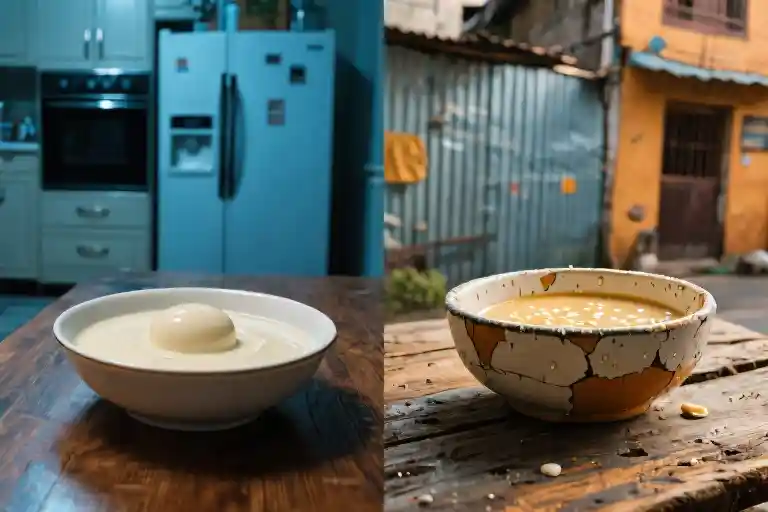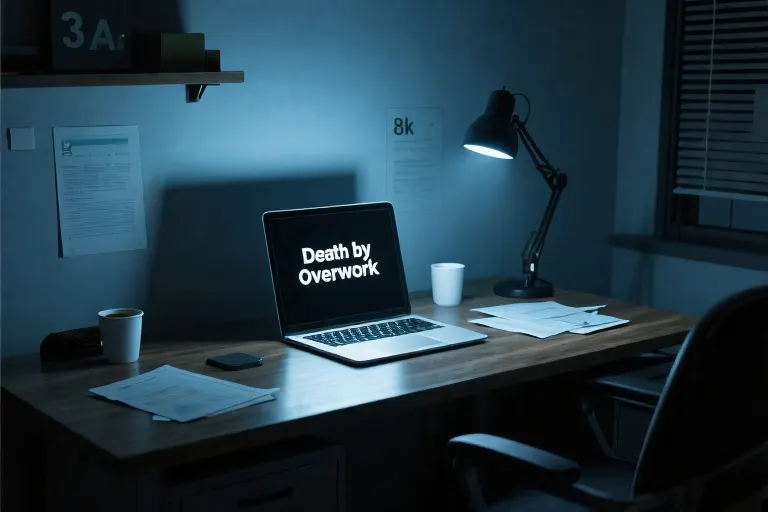The spoon trembled slightly in twelve-year-old Daiane’s hand as she scooped a bite of chilled pudding at her classmate’s house. The cold sweetness on her tongue carried the unfamiliar metallic tang of refrigeration – a luxury her family’s makeshift home in Brazil’s favelas couldn’t accommodate. Outside, the rhythmic sounds of samba from a neighbor’s radio mixed with the ever-present hum of generator-powered freezers in the wealthier homes uphill.
At that exact moment, somewhere in the world, another life ended by suicide. The World Health Organization’s grim statistics would later reveal this happens every forty seconds, with 77% of these tragedies occurring in low- and middle-income countries like her homeland. The geography of birth, it seems, writes invisible equations that calculate everything from dessert temperatures to despair thresholds.
“We were eating the same recipe,” Machado recalls, now a research fellow at Harvard Medical School studying mental health disparities, “but hers came from an appliance that cost more than my father’s monthly wage.” That childhood moment crystallized what would become her life’s work: understanding how the postal code of one’s birth determines mental health outcomes with mathematical precision.
The contrast between those two bowls of pudding – one kept cold by electricity, the other by the occasional block of ice – mapped onto larger patterns she’d document professionally. In Brazil, where the richest 1% hold nearly 30% of the country’s wealth, mental health resources follow similar distribution curves. Private schools like hers had counseling offices with leather chairs; public clinics a few miles away stocked expired antidepressants when they stocked anything at all.
Machado’s journey from noticing these disparities to measuring them spans continents and academic degrees, but began with simple observations. “When my friend’s mother served that pudding,” she says, “I didn’t yet know the term ‘social determinants of health.’ But I understood that some homes had sweetness you could preserve, and others had it spoiling in the heat.”
This tension between individual resilience and systemic barriers defines both her personal narrative and professional findings. The same year she first tasted refrigerated dessert, WHO data shows Brazilian suicide rates were quietly climbing by 7% annually – a trend invisible to policymakers until researchers like Machado connected it to unemployment spikes in the country’s northeast. Her work now reveals how mental health inequality operates like climate change: a global crisis felt most acutely by those with the fewest resources to adapt.
As the pandemic later proved, these disparities aren’t mere academic concerns. When COVID-19 hit, countries with preexisting mental health infrastructure could pivot to telehealth; others saw suicide hotlines collapse under unprecedented demand. The chilling reality Machado’s research exposes: mental healthcare access isn’t just unequal, but engineered that way by economic systems valuing some lives over others.
Yet in that divide between two children eating the same pudding under different circumstances, she also found purpose. “What if,” her life’s work asks, “we could recalibrate the scales?”
The Two Ends of the Rubber Band
The rain hammered against the corrugated metal roof like a thousand impatient fingers when Daiane’s father made his decision. That evening, he quietly removed the heirloom pocket watch – the only valuable object their family owned – and walked three miles through flooded streets to the pawnshop. The next morning, 12-year-old Daiane would begin classes at Colégio Batista, where monthly tuition cost more than her father’s weekly wages as a bakery assistant.
This moment contained all the contradictions that would later define her research: the brutal arithmetic of poverty where timepieces trade for textbooks, the quiet violence of systemic inequality masked as personal sacrifice. The watch had survived four generations in their family; its loss bought exactly 37 days of access to education’s transformative power.
At Colégio Batista, the nurse’s office stocked German-made antidepressants alongside bandages. Back home in Jardim São Remo, the community clinic’s mental health supplies consisted of two outdated pamphlets about ‘nervous weakness’ and a padlocked cabinet containing mostly sedatives. Daiane began carrying aspirin from school to give her mother, who suffered chronic headaches from working three cleaning jobs – physical manifestations of what she’d later recognize as depression untreated.
Then came the summer afternoon when screams shattered the neighborhood’s exhausted silence. Senhora Oliveira’s daughter, 14-year-old Marcela, had swallowed rat poison after another beating from her alcoholic father. As women rushed about with bowls of saltwater (the only emetic they knew), Daiane watched Marcela convulse on the dirt floor, her school uniform skirt stained purple from the cheap dye. The ambulance took 47 minutes to arrive from the private hospital that refused public patients. Marcela survived, but something in Daiane’s understanding of the world didn’t.
‘That’s when I realized mental health isn’t about willpower,’ she told me years later in her Harvard office, fingers tracing the scar on her left wrist where Marcela had clawed her during the seizure. ‘It’s about whether your clinic stocks naloxone or just prayer cards. Whether your school has a counselor or just a disciplinary officer. Whether your father can trade his history for your future.’
These dichotomies – between the medicine available at her school versus her community, between Marcela’s fate and her own – became the foundation of Machado’s groundbreaking work on mental health inequality. The rubber band metaphor emerged in her first published paper: society stretches between those who can access care and those who snap under preventable pressure. Her research would eventually prove that in low- and middle-income countries, the distance between these two endpoints isn’t just measured in economic terms, but in lives lost.
Decoding the Formula of Inequality
The numbers never lie, but they often hide in plain sight. When Daiane Borges Machado published her 2015 study correlating GDP fluctuations with suicide rates, the academic world gained something rare—an equation that quantified despair. For every 1% drop in per capita GDP, male suicide rates climbed by 1.2% in low- and middle-income countries. This wasn’t just statistics; it was mathematics measuring the cost of inequality.
The Hidden Epidemic
In Rajasthan’s sunbaked villages, death certificates tell stories in code. Machado’s fieldwork revealed nearly 60% of suicides were logged as ‘accidental deaths’—a bureaucratic euphemism masking cultural stigma. “When families report suicide,” she explains, “they risk losing community support or facing legal consequences.” This data black hole distorts global health priorities, leaving interventions to operate half-blind.
Signals in the Static
Frustrated by unreliable economic indicators, Machado’s team pioneered an unconventional metric: mobile phone tower density. Their hypothesis? Communication infrastructure mirrors development in ways GDP can’t capture. The results startled even seasoned researchers—areas with sparser towers showed suicide rates 3.4 times higher than well-connected zones, regardless of official poverty lines.
“We’re not just studying mental health,” Machado reflects, “we’re reverse-engineering the architecture of hope.” Her methodology now informs WHO’s mental health gap action programme, proving sometimes the most profound truths hide in the spaces between signals.
When the Pandemic Turned Cracks into Chasms
The cotton fields of Vidarbha region usually shimmer with white gold during harvest season. But in April 2020, the locked-down villages witnessed a different kind of yield—empty pesticide containers piling up outside mud-brick homes. Daiane Machado’s team tracked seventeen farmer suicides in forty-eight hours through local health workers’ WhatsApp groups, each case tied to loan sharks demanding repayment despite crop failures.
‘We saw the same pattern across LMICs,’ Machado explains, zooming through pandemic mortality charts during our Zoom call. Her cursor circles spikes in Kenya’s suicide hotline data (300% increase among teens), then jumps to Brazil’s underfunded clinics where antidepressants became scarcer than ventilators. The cruel paradox? While mental health needs ballooned by 200%, health budgets in these countries shrank by nearly a third as governments redirected funds toward COVID emergencies.
Her research exposed how preexisting vulnerabilities became fatal under pressure:
- Debt dominoes: India’s 40% suicide surge among farmers mirrored 2008 financial crisis patterns, but with lockdowns preventing migrant work escapes
- Digital deserts: 78% of rural Brazilian patients couldn’t access teletherapy due to spotty internet, prompting Machado’s SMS screening system
- The accuracy breakthrough: By analyzing keyword combinations in text responses (like ‘can’t sleep’ + ‘debts’), the algorithm identified 82% of high-risk individuals without requiring smartphones
A health worker in Nairobi demonstrated the tool’s cultural adaptation during our interview—instead of clinical terms, the Kiswahili version asks about ‘heavy hearts’ and ‘lost laughter.’ This linguistic nuance reflects Machado’s core belief: ‘Mental health solutions must speak the language of the streets, not textbooks.’
The chapter’s most unsettling revelation comes through comparative charts. While wealthy nations temporarily increased mental health spending during lockdowns (Germany +19%, Australia +15%), LMICs like Brazil and Kenya made cuts averaging 32%. Machado’s voice tightens discussing a pregnant teenager in Recife who overdosed on painkillers after being turned away from an overcrowded clinic: ‘Virus deaths made headlines. These silent casualties didn’t.’
Yet within the grim statistics glimmer Machado’s pragmatic innovations. Her team’s follow-up study showed that training pharmacy workers to dispense mental health first aid (like recognizing suicide risk when villagers buy rat poison) reduced emergencies by 44% in pilot communities. ‘Sometimes,’ she notes, ‘the best tools are already in people’s hands—we just need to teach them to see differently.’
The Unfinished Equation
The supermarket scanner beeps rhythmically as Carla, now a mother of three, slides discounted rice packets across the red laser. Thirty years ago, she shared chilled guava pudding with a wide-eyed Daiane in her family’s first refrigerator—an avocado-colored Electrolux that symbolized middle-class stability in their Brazilian town. Today, that same town reports suicide rates 22% higher than pre-pandemic levels, while Daiane analyzes the data from her Harvard office.
This asymmetry lingers in the air as Machado’s team finalizes three scalable interventions for LMICs:
- Community Mental Health First Responders
Training local grandmothers and taxi drivers in psychological first aid—the same way they’d learn CPR. In pilot programs, these volunteers identified 68% of high-risk cases before crises occurred, using nothing but a checklist and WhatsApp voice notes. - Prescription by Text Message
The SMS triage system born during India’s farmer crisis now delivers cognitive behavioral therapy exercises via feature phones. A Kenyan teen receiving “Type 3 for breathing techniques” needs no smartphone or broadband—just the 2G network covering 93% of sub-Saharan Africa. - Painkiller Subsidies That Save Lives
By making paracetamol cheaper than rat poison (a common suicide method in agricultural regions), Peru saw a 14% drop in impulsive attempts. Machado’s economic models show this costs less than post-attempt ICU care.
Yet the calculator still flashes with unanswered variables. When 8-year-old Lívia—Daiane’s daughter—colors world maps at her Boston kindergarten, will the crimson zones marking high suicide rates shrink or spread? The algorithms can’t account for this: whether privilege, once attained, will be leveraged to redistribute mental health equity, or simply hoarded like the last doses of lithium in a Caracas pharmacy.
Machado keeps Carla’s handwritten pudding recipe tucked in her research notebook. Some measurements remain approximate—a pinch of this, a drizzle of that—much like their unfinished work. The 77% statistic may yet bend, but never break cleanly. Progress moves in decimals: 76.9%, 76.8%, each fraction representing someone’s child who made it home before dark.





